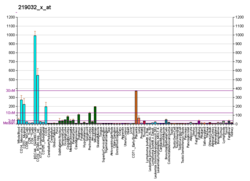Top Qs
Timeline
Chat
Perspective
OPN3
Protein-coding gene in the species Homo sapiens From Wikipedia, the free encyclopedia
Remove ads
Opsin-3 also known as encephalopsin or panopsin[4] is a protein that, in humans, is encoded by the OPN3 gene.[5][6][7] Alternative splicing of this gene results in multiple transcript variants encoding different protein isoforms.[8]
Remove ads
Function
Opsins are members of the G protein-coupled receptor superfamily. In addition to the visual opsins, mammals possess several photoreceptive non-visual opsins that are expressed in tissues outside the eye. The opsin-3 gene is strongly expressed in brain and testis and weakly expressed in liver, placenta, heart, lung, skeletal muscle, kidney, and pancreas. The gene is expressed in the skin[8] and may also be expressed in the retina. The protein has the canonical features of a photoreceptive opsin protein,[7] however in human skin, OPN3 is not photoreceptive and acts as a negative regulator of melanogenesis.[9]
Remove ads
Applications
When OPN3 analogues are expressed in neurons, activation by light inhibits neurotransmitter release.[10][11] This makes these analogues useful tools for optogenetic silencing, a method to study the impact of specific neurons on brain function.
References
Further reading
Wikiwand - on
Seamless Wikipedia browsing. On steroids.
Remove ads



